Alfred Gray
Modern
Differential
Geometry of
Curves and
Surfaces
with Mathematica R
Third Edition by
Elsa Abbena and Simon Salamon
�
�
i
Preface to the Second Edition
1
Modern Differential Geometry of Curves and Surfaces is a traditional text, but it
uses the symbolic manipulation program Mathematica. This important computer
program, available on PCs, Macs, NeXTs, Suns, Silicon Graphics Workstations
and many other computers, can be used very effectively for plotting and comput-
ing. The book presents standard material about curves and surfaces, together
with accurate interesting pictures, Mathematica instructions for making the pic-
tures and Mathematica programs for computing functions such as curvature and
torsion.
Although Curves and Surfaces makes use of Mathematica, the book should also
be useful for those with no access to Mathematica. All calculations mentioned
in the book can in theory be done by hand, but some of the longer calculations
might be just as tedious as they were for differential geometers in the 19th
century. Furthermore, the pictures (most of which were done with Mathematica)
elucidate concepts, whether or not Mathematica is used by the reader.
The main prerequisite for the book is a course in calculus, both single variable
and multi-variable. In addition, some knowledge of linear algebra and a few
basic concepts of point set topology are needed. These can easily be obtained
from standard sources. No computer knowledge is presumed. In fact, the book
provides a good introduction to Mathematica; the book is compatible with both
versions 2.2 and 3.0. For those who want to use Curves and Surfaces to learn
Mathematica, it is advisable to have access to Wolfram’s book Mathematica for
reference. (In version 3.0 of Mathematica, Wolfram’s book is available through
the help menus.)
Curves and Surfaces is designed for a traditional course in differential geom-
etry. At an American university such a course would probably be taught at
the junior-senior level. When I taught a one-year course based on Curves and
Surfaces at the University of Maryland, some of my students had computer
experience, others had not. All of them had acquired sufficient knowledge of
Mathematica after one week.
I chose not to have computers in my classroom
because I needed the classroom time to explain concepts. I assigned all of the
problems at the end of each chapter. The students used workstations, PCs
1This is a faithful reproduction apart from the updating of chapter references. It already
incorporated the Preface to the First Edition dating from 1993.
�
ii
and Macs to do those problems that required Mathematica. They either gave
me a printed version of each assignment, or they sent the assignment to me by
electronic mail.
Symbolic manipulation programs such as Mathematica are very useful tools
for differential geometry. Computations that are very complicated to do by
hand can frequently be performed with ease in Mathematica. However, they are
no substitute for the theoretical aspects of differential geometry. So Curves and
Surfaces presents theory and uses Mathematica programs in a complementary
way.
Some of the aims of the book are the following.
• To show how to use Mathematica to plot many interesting curves and sur-
faces, more than in the standard texts. Using the techniques described in
Curves and Surfaces, students can understand concepts geometrically by
plotting curves and surfaces on a monitor and then printing them. The
effect of changes in parameters can be strikingly portrayed.
• The presentation of pictures of curves and surfaces that are informative,
interesting and accurate. The book contains over 400 illustrations.
• The inclusion of as many topics of the classical differential geometry and
surfaces as possible. In particular, the book contains many examples to
illustrate important theorems.
• Alleviation of the drudgery of computing things such as the curvature
and torsion of a curve in space. When the curvature and torsion become
too complicated to compute, they can be graphed instead. There are
more than 175 miniprograms for computing various geometric objects and
plotting them.
• The introduction of techniques from numerical analysis into differential
geometry. Mathematica programs for numerical computation and draw-
ing of geodesics on an arbitrary surface are given. Curves can be found
numerically when their torsion and curvature are specified.
• To place the material in perspective through informative historical notes.
There are capsule biographies with portraits of over 75 mathematicians
and scientists.
• To introduce interesting topics that, in spite of their simplicity, deserve to
be better known. I mention triply orthogonal systems of surfaces (Chap-
ter 19), Bj¨orling’s formula for constructing a minimal surface containing
a given plane curve as a geodesic (Chapter 22) and canal surfaces and
cyclides of Dupin as Maxwell discussed them (Chapter 20).
�
iii
• To develop a dialect of Mathematica for handling functions that facilitates
the construction of new curves and surfaces from old. For example, there
is a simple program to generate a surface of revolution from a plane curve.
• To provide explicit definitions of curves and surfaces. Over 300 Mathematica
definitions of curves and surfaces can be used for further study.
The approach of Curves and Surfaces is admittedly more computational than
is usual for a book on the subject. For example, Brioschi’s formula for the
Gaussian curvature in terms of the first fundamental form can be too com-
plicated for use in hand calculations, but Mathematica handles it easily, either
through computations or through graphing the curvature. Another part of
Mathematica that can be used effectively in differential geometry is its special
function library. For example, nonstandard spaces of constant curvature can be
defined in terms of elliptic functions and then plotted.
Frequently, I have been asked if new mathematical results can be obtained by
means of computers. Although the answer is generally no, it is certainly the case
that computers can be an effective supplement to pure thought, because they
allow experimentation and the graphs provide insights into complex relation-
ships. I hope that many research mathematicians will find Curves and Surfaces
useful for that purpose. Two results that I found with the aid of Mathematica
are the interpretation of torsion in terms of tube twisting in Chapter 7 and the
construction of a conjugate minimal surface without integration in Chapter 22.
I have not seen these results in the literature, but they may not be new.
The programs in the book, as well as some descriptive Mathematica note-
books, will eventually be available on the web.
Sample Course Outlines
There is ample time to cover the whole book in three semesters at the under-
graduate level or two semesters at the graduate level. Here are suggestions for
courses of shorter length.
• One semester undergraduate differential geometry course: Chapters 1, 2, 7,
9 – 13, parts of 14 – 16, 27.
• Two semester undergraduate differential geometry course: Chapters 1 – 3, 9 –
19, 27.
• One semester graduate differential geometry course: Chapters 1, 2, 7 – 13,
15 – 19, parts of 22 – 27.
• One semester course on curves and their history: Chapters 1 – 8.
�
iv
• One semester course on Mathematica and graphics Chapters 1 – 6, 7 – 11,
parts of 14 – 19, 23, and their notebooks.
I have tried to include more details than are usually found in mathematics books.
This, plus the fact that the Mathematica programs can be used to elucidate
theoretical concepts, makes the book easy to use for independent study.
Curves and Surfaces is an ongoing project. In the course of writing this book,
I have become aware of the vast amount of material that was well-known over
a hundred years ago, but now is not as popular as it should be. So I plan
to develop a web site, and to write a problem book to accompany the present
text. Spanish, German, Japanese and Italian versions of Curves and Surfaces are
already available.
Graphics
Although Mathematica graphics are very good, and can be used to create Quick
Time movies, the reader may also want to consider the following additional
display methods:
• Acrospin is an inexpensive easy-to-use program that works on even the
humblest PC.
• Geomview is a program for interactive display of curves and surfaces. It
works on most unix-type systems, and can be freely downloaded from
http://www.geomview.org
• Dynamic Visualizer is an add-on program to Mathematica that allows inter-
active display. Details are available from http://www.wolfram.com
• AVS programs (see the commercial site http://www.avs.com) have been devel-
oped by David McNabb at the University of Maryland (http://www.umd.edu)
for spectacular stereo three-dimensional images of the surfaces described
in this book.
A Perspective
Mathematical trends come and go. R. Osserman in his article (‘The Geome-
try Renaissance in America: 1938–1988’ in A Century of Mathematics in America,
volume 2, American Mathematical Society, Providence, 1988) makes the point
that in the 1950s when he was a student at Harvard, algebra dominated mathe-
matics, the attention given to analysis was small, and the interest in differential
geometry was converging to zero.
It was not always that way. In the last half of the 19th century surface theory
was a very important area of mathematics, both in research and teaching. Brill,
�
v
then Schilling, made an extensive number of plaster models available to the
mathematical public. Darboux’s Lec¸ons sur la Th ´eorie G ´en ´erale des Surfaces and
Bianchi’s Lezioni di Geometria Differenziale were studied intensely. I attribute the
decline of differential geometry, especially in the United States, to the rise of
tensor analysis. Instead of drawing pictures it became fashionable to raise and
lower indices.
I strongly feel that pictures need to be much more stressed in differential
geometry than is presently the case. It is unfortunate that the great differential
geometers of the past did not share their extraordinary intuitions with others
by means of pictures. I hope that the present book contributes in some way to
returning the differential geometry of curves and surfaces to its proper place in
the mathematics curriculum.
I wish to thank Elsa Abbena, James Anderson, Thomas Banchoff, Marcel
Berger, Michel Berry, Nancy Blachman, William Bruce, Renzo Caddeo, Eu-
genio Calabi, Thomas Cecil, Luis A. Cordero, Al Currier, Luis C. de Andr´es,
Mirjana Djori´c, Franco Fava, Helaman Fergason, Marisa Fern´andez, Frank Fla-
herty, Anatoly Fomenko, V.E. Fomin, David Fowler, George Francis, Ben Fried-
man, Thomas Friedrick, Pedro M. Gadea, Sergio Garbiero, Laura Geatti, Peter
Giblin, Vladislav Goldberg, William M. Goldman, Hubert Gollek, Mary Gray,
Joe Grohens, Garry Helzer, A.O. Ivanov, Gary Jensen, Alfredo Jim´enez, Raj
Jakkumpudi, Gary Jensen, David Johannsen, Joe Kaiping, Ben Kedem, Robert
Kragler, Steve Krantz, Henning Leidecker, Stuart Levy, Mats Liljedahl, Lee
Lorch, Sanchez Santiago Lopez de Medrano, Roman Maeder, Steen Markvorsen,
Mikhail A. Malakhaltsev, Armando Machado, David McNabb, Jos´e J. Menc´ıa,
Michael Mezzino, Vicente Miquel Molina, Deanne Montgomery, Tamara Mun-
zner, Emilio Musso, John Novak, Barrett O’Neill, Richard Palais, Mark Phillips,
Lori Pickert, David Pierce, Mark Pinsky, Paola Piu, Valeri Pouchnia, Rob Pratt,
Emma Previato, Andreas Iglesias Prieto, Lilia del Riego, Patrick Ryan, Gia-
como Saban, George Sadler, Isabel Salavessa, Simon Salamon, Jason P. Schultz,
Walter Seaman, B.N. Shapukov, V.V. Shurygin, E.P. Shustova, Sonya ˇSimek,
Cameron Smith, Dirk Struik, Rolf Sulanke, John Sullivan, Daniel Tanr`e, C.
Terng, A.A. Tuzhilin, Lieven Vanhecke, Gus Vlahacos, Tom Wickam-Jones and
Stephen Wolfram for valuable suggestions.
Alfred Gray
July 1998
�
vi
Preface to the Third Edition
Most of the material of this book can be found, in one form or another, in
the Second Edition. The exceptions to this can be divided into three categories.
Firstly, a number of modifications and new items had been prepared by
Alfred Gray following publication of the Second Edition, and we have been
able to incorporate some of these in the Third Edition. The most obvious is
Chapter 21. In addition, we have liberally expanded a number of sections by
means of additional text or graphics, where we felt that this was warranted.
The second is Chapter 23, added by the editors to present the popular theory
of quaternions. This brings together many of the techniques in the rest of the
book, combining as it does the theory of space curves and surfaces.
The third concerns the Mathematica code presented in the notebooks. Whilst
this is closely based on that written by the author and displayed in previous
editions, many programs have been enhanced and sibling ones added. This is to
take account of the progressive presentation that Mathematica notebooks offer,
and a desire to publish instructions to generate every figure in the book.
The new edition does differ notably from the previous one in the manner
in which the material is organized. All Mathematica code has been separated
from the body of the text and organized into notebooks, so as to give readers
interactive access to the material. There is one notebook to accompany each
chapter, and it contains relevant programs in parallel with the text, section
by section. An abridged version is printed at the end of the chapter, for close
reference and to present a fair idea of the programs that ride in tandem with
the mathematics. The distillation of computer code into notebooks also makes
it easier to conceive of rewriting the programs in a different language, and a
project is underway to do this for Maple.
The full notebooks can be downloaded from the publisher’s site
http://www.crcpress.com
Their organization and layout is discussed in more detail in Notebook 0 below.
They contain no output, as this can be generated at will. All the figures in the
book were compiled automatically by merely evaluating the notebooks chapter
by chapter, and this served to ‘validate’ the notebooks using Version 5.1 of
Mathematica.
It is the editors’ intention to build up an on-line database of
solutions to the exercises at the end of each chapter. Those marked M are
designed to be solved with the help of a suitable Mathematica program.
�


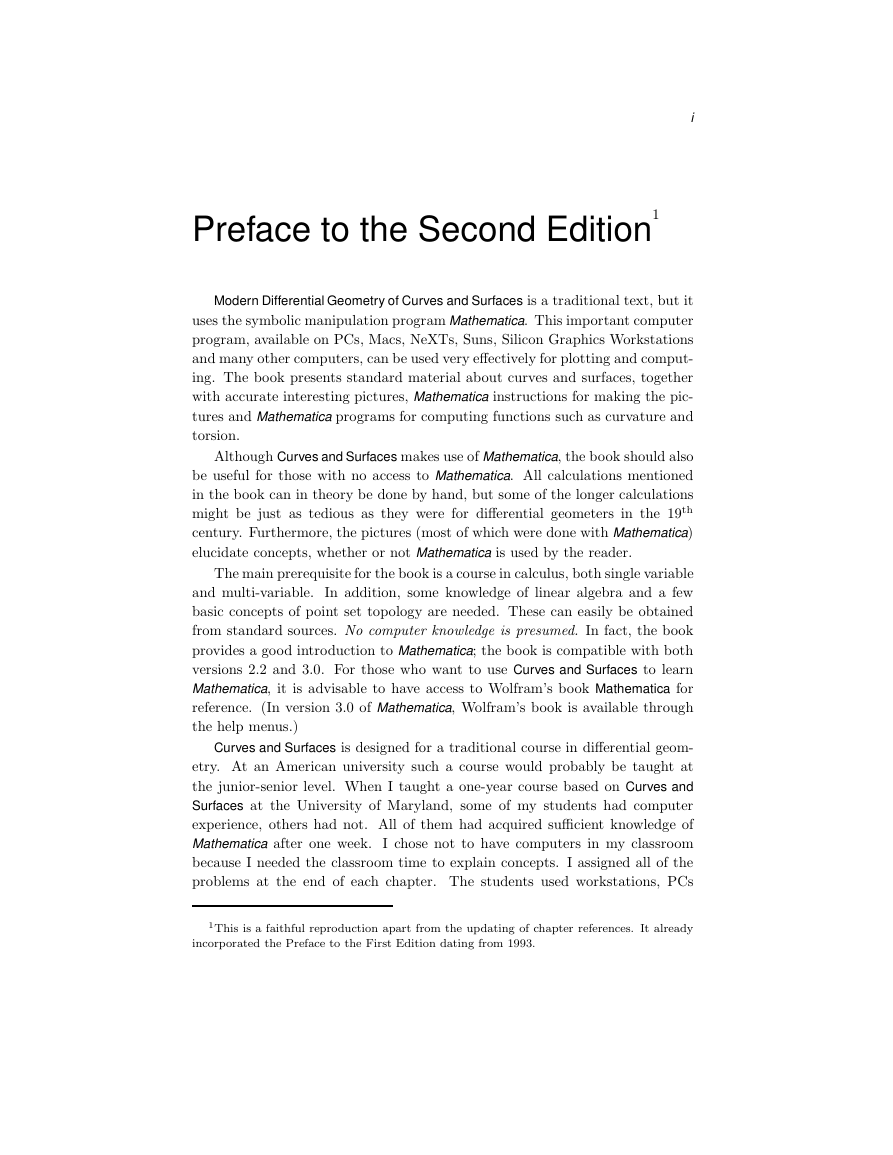
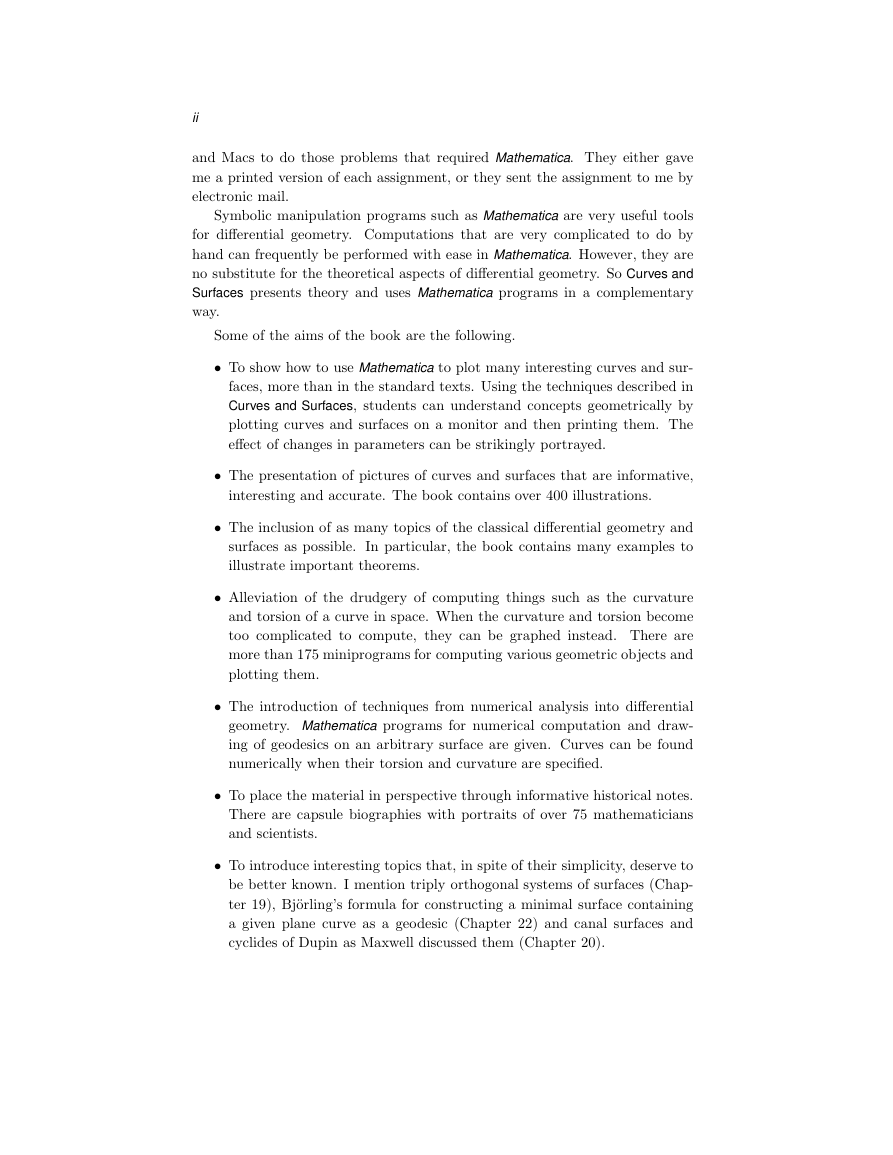
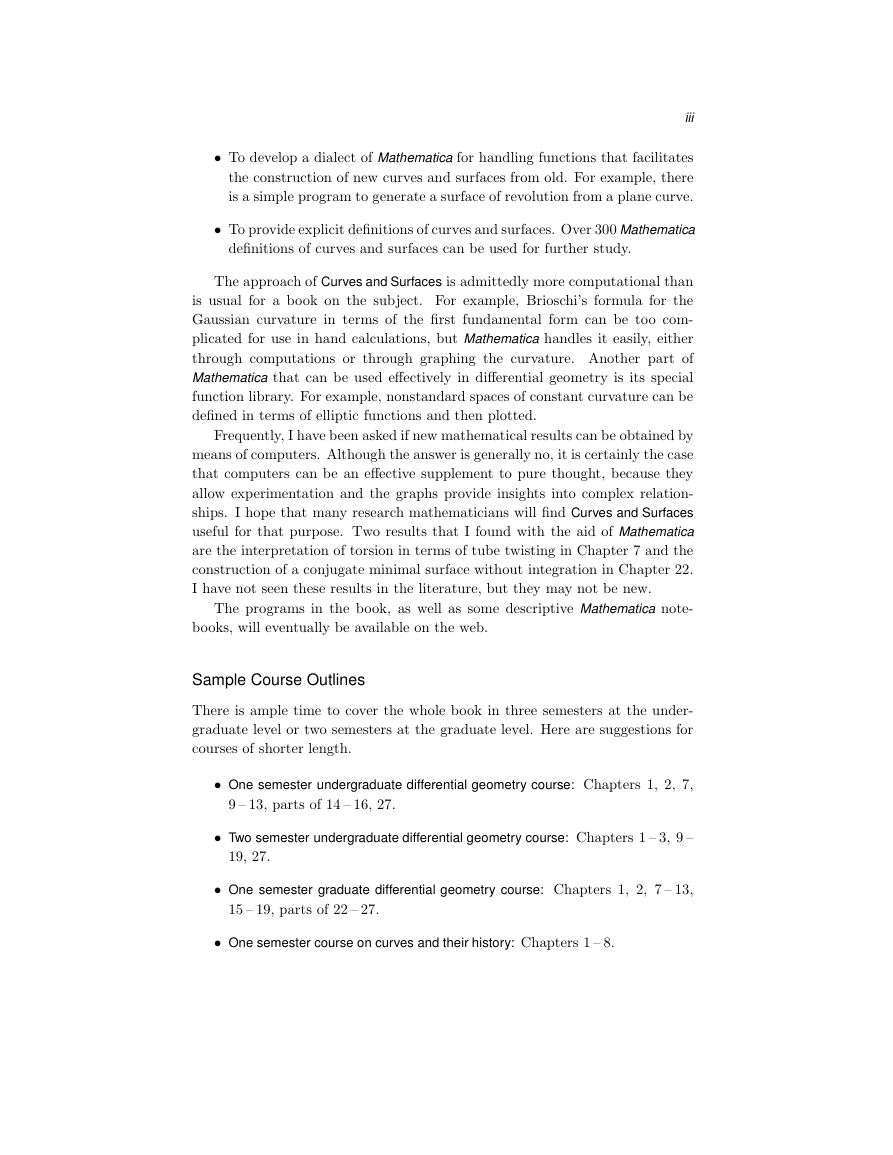
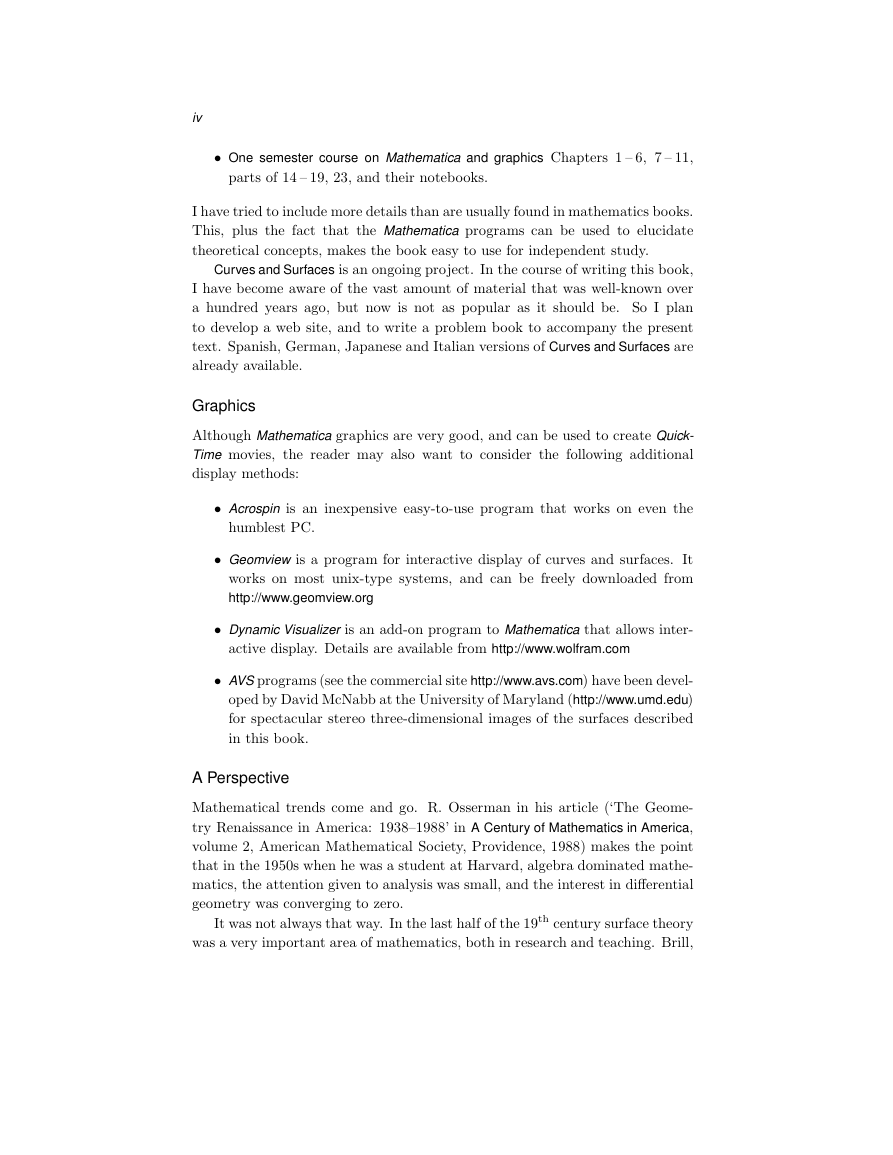

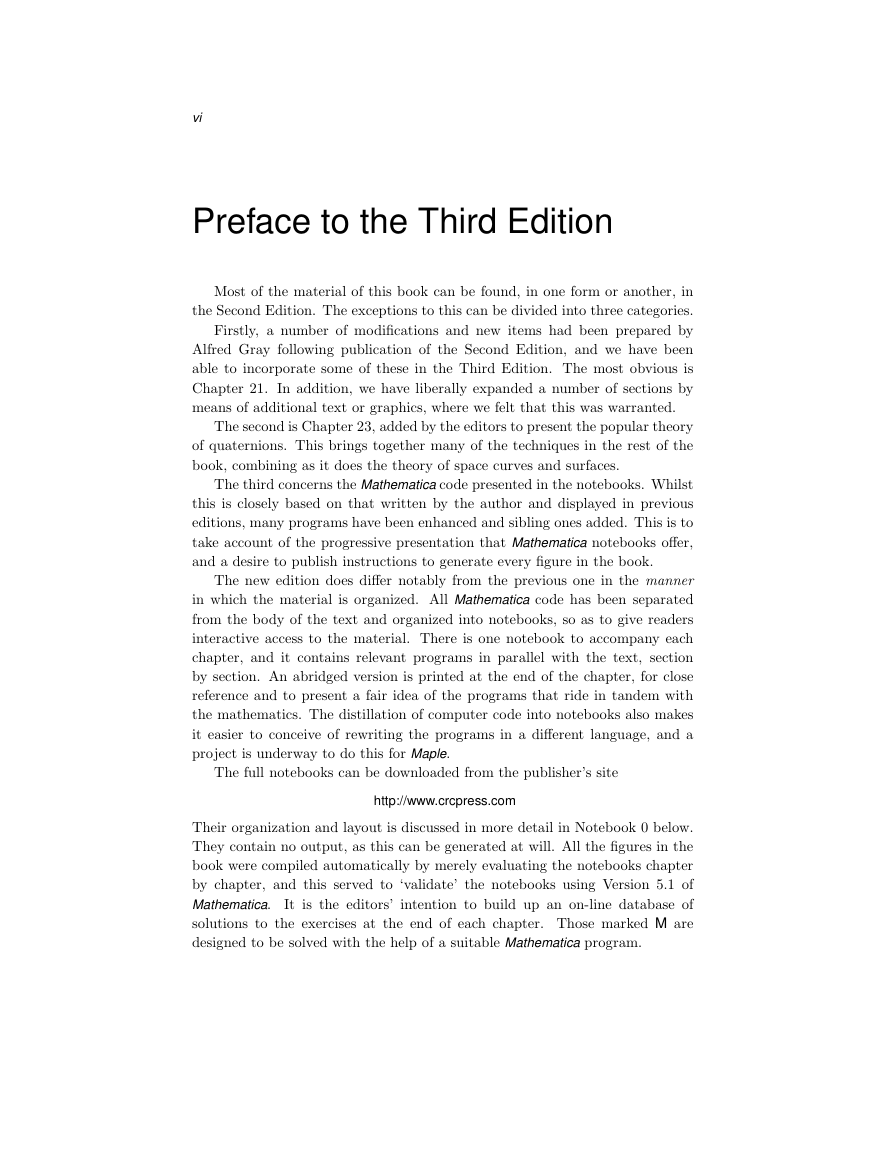








 2023年江西萍乡中考道德与法治真题及答案.doc
2023年江西萍乡中考道德与法治真题及答案.doc 2012年重庆南川中考生物真题及答案.doc
2012年重庆南川中考生物真题及答案.doc 2013年江西师范大学地理学综合及文艺理论基础考研真题.doc
2013年江西师范大学地理学综合及文艺理论基础考研真题.doc 2020年四川甘孜小升初语文真题及答案I卷.doc
2020年四川甘孜小升初语文真题及答案I卷.doc 2020年注册岩土工程师专业基础考试真题及答案.doc
2020年注册岩土工程师专业基础考试真题及答案.doc 2023-2024学年福建省厦门市九年级上学期数学月考试题及答案.doc
2023-2024学年福建省厦门市九年级上学期数学月考试题及答案.doc 2021-2022学年辽宁省沈阳市大东区九年级上学期语文期末试题及答案.doc
2021-2022学年辽宁省沈阳市大东区九年级上学期语文期末试题及答案.doc 2022-2023学年北京东城区初三第一学期物理期末试卷及答案.doc
2022-2023学年北京东城区初三第一学期物理期末试卷及答案.doc 2018上半年江西教师资格初中地理学科知识与教学能力真题及答案.doc
2018上半年江西教师资格初中地理学科知识与教学能力真题及答案.doc 2012年河北国家公务员申论考试真题及答案-省级.doc
2012年河北国家公务员申论考试真题及答案-省级.doc 2020-2021学年江苏省扬州市江都区邵樊片九年级上学期数学第一次质量检测试题及答案.doc
2020-2021学年江苏省扬州市江都区邵樊片九年级上学期数学第一次质量检测试题及答案.doc 2022下半年黑龙江教师资格证中学综合素质真题及答案.doc
2022下半年黑龙江教师资格证中学综合素质真题及答案.doc